Hello, my dear students and future lifesavers!
Welcome to the next exciting lesson in the Steemit Learning Challenge on essentials of fsirst aid skills! I hope you all are feeling some more prepared and confident with each topic we explored in the past weeks. Today, we're tackling a situation that can escalate from scary to life-threatening within seconds, yes its, choking and airway obstruction.
Imagine you're at a family dinner, maybe a public event or it can even home alone and someone begins to choke. The ability to recognize the signs and respond immediately can mean the difference between life and tragedy. Whether it's a child struggling with a small object, an adult caught off guard while eating or even yourself in an emergency, knowing the right steps to take is invaluable.
In medical emergencies, choking ranks among the most critical yet preventable situations. This lesson focuses on equipping you with the knowledge and skills to recognize and respond effectively to airway obstructions. By the end, you'll not only understand the mechanics of choking but also gain confidence in applying life-saving first aid techniques tailored to different age groups.
Whether you're a healthcare professional, a caregiver, or simply someone who values safety, this guide ensures you're prepared for one of the most common yet urgent scenarios anyone can face. Let’s dive in and learn how to stay calm, act swiftly, and make a difference when it truly matters!
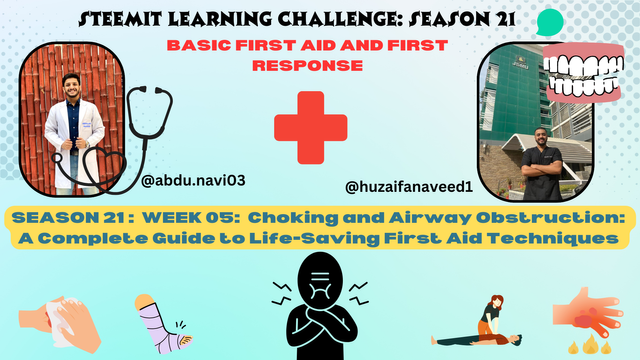
CHOKING |
|---|
Choking occurs when a foreign object blocks the airway, leading to difficulty in breathing. It can be partial (allowing some airflow) or complete (blocking airflow entirely).
| Aspect | Partial Choking | Complete Choking |
|---|---|---|
| Definition | Airway is partially blocked, allowing limited airflow. | Airway is completely blocked, preventing airflow entirely. |
| Symptoms | - Forceful coughing | - Inability to cough, speak, or cry |
| - Gagging or noisy breathing (wheezing) | - Silent attempts to breathe | |
| - Some ability to speak or cry | - Cyanosis (blue skin) | |
| - Panic and distress | - Universal choking sign (clutching throat) | |
| - Loss of consciousness if untreated | ||
| Airflow | Some airflow is still present. | No airflow at all. |
| Danger Level | Less severe; may resolve with coughing. | Life-threatening; requires immediate action. |
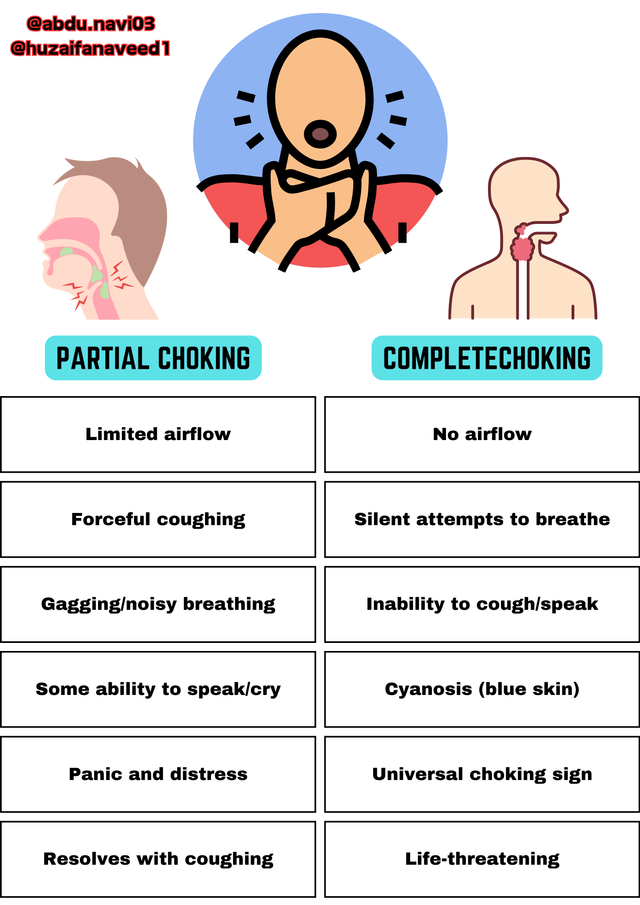
CHOKING vs OTHER MEDICAL EMERGENCIES |
|---|
Choking is a distinct medical emergency with specific signs and symptoms, primarily characterized by airway obstruction. However, it is often confused with other urgent medical conditions. Understanding the key differences between choking and other emergencies, such as heart attacks or strokes, can help individuals respond more effectively. The table below highlights these differences, focusing on aspects like causes, symptoms, and response actions
| Aspect | Choking | Other Medical Emergencies |
|---|---|---|
| Primary Cause | Obstruction in the airway | Varies: cardiac issues, stroke, seizures, etc. |
| Onset | Sudden onset while eating or handling objects | Gradual or sudden, depending on the condition |
| Universal Sign | Clutching the throat | Absent in other emergencies |
| Breathing | Noisy (partial choking) or silent (complete choking) | Varies: labored, irregular, or paused |
| Ability to Speak | Limited or absent | Often preserved except in seizures |
| Skin Appearance | Cyanosis in severe cases | Swelling, pallor, or flushing based on condition |
| Key Symptoms | Sudden coughing, gagging, or wheezing | Chest pain (heart attack), swelling (anaphylaxis), or muscle jerking (seizures) |

RECOGNIZING CHOKING & STEPS TO HANDLE |
|---|
1. ASSESS THE SITUATION
Partial Obstruction: If the person can cough, speak, or breathe, encourage coughing to clear the obstruction. Do not interfere unless their condition worsens.
Complete Obstruction: If the person cannot breathe, speak, or cough, beggin choking relieving techniques and act immediately
1. RECOGNIZING THE EMERGENCY
If you're unable to cough, speak, or breathe, and feel your airway is fully blocked, act immediately.
Clutch your throat with your hands as a reflexive universal choking sign.
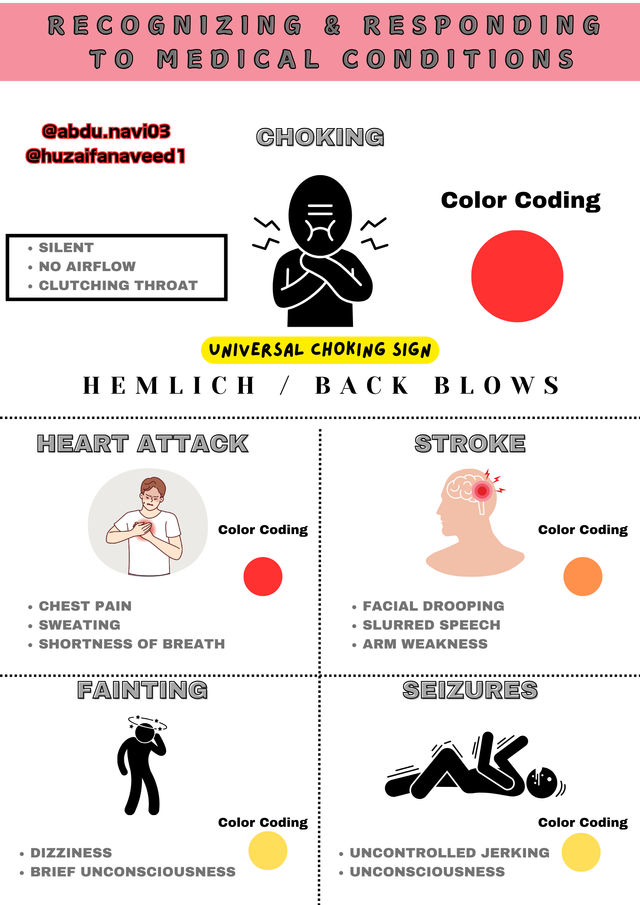
2. STEPS FOR SELF-HEMLICH MANEUVER
A. Using Your Fist and Hand
Make a fist with one hand and place it just above your navel (belly button) and below your ribcage.
Grasp your fist with your other hand.
Perform quick, upward thrusts, using the same motion as if someone else were performing the Heimlich Maneuver on you.
B. Using a Fixed Object
If you're unable to generate enough force with your hands, lean over a sturdy object like the back of a chair, table edge, or countertop.
Position the object just above your navel and below your ribcage.
Thrust your upper abdomen against the object forcefully and repeatedly until the obstruction is dislodged.
3. FOLLOW-UP
Once the object is expelled, monitor for signs of airway injury.
Seek medical attention to ensure no further complications, even if you feel fine
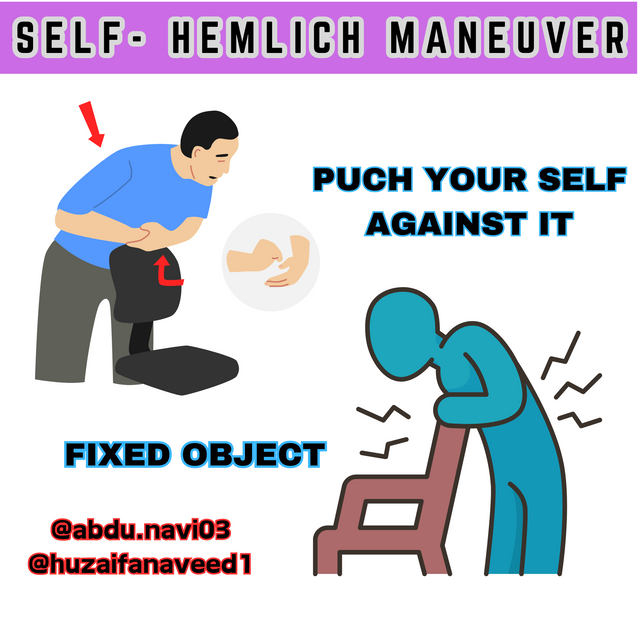
2. FIRST AID PROTOCOL
1. FOR CONSCIOUSS ADULTS AND CHILDREN (>1 year):
A. Back Blows:
Stand slightly behind the person.
Support their chest with one hand and lean them forward.
Deliver 5 sharp back blows between the shoulder blades using the heel of your hand.
B. Abdominal Thrusts (Heimlich Maneuver):
Stand behind the person and wrap your arms around their waist.
Make a fist and place it just above the navel.
Grasp your fist with your other hand and perform 5 quick upward thrusts.
C. Alternate Back Flows & Abdominal Thrusts
- Continue alternating 5 back blows and 5 abdominal thrusts until the object is dislodged or the person becomes unresponsive.
2. FOR INFANTS (<1 year):
A. Back Blows:
Place the infant face-down along your forearm, supporting their head and neck.
Deliver 5 firm back blows between the shoulder blades.
B. Chest Thrusts:
Turn the infant face-up along your forearm, keeping their head lower than the chest.
Use two fingers to perform 5 chest thrusts in the center of the chest, just below the nipple line.
C. Alternate Steps:
- Repeat 5 back blows and 5 chest thrusts until the object is expelled or the infant becomes unresponsive.
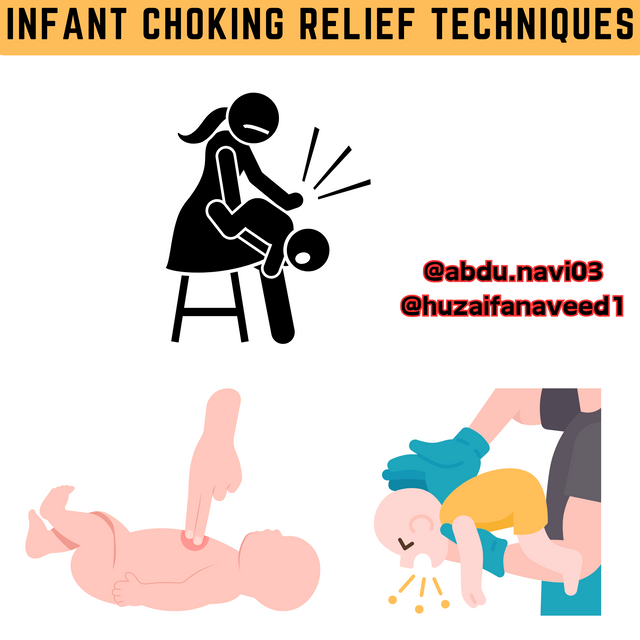
3. IF THE PERSON BECOMES UNRESPONSIVE
FOR ADULTS & CHILDREN (>1 year):
Call for emergency services immediately.
Begin CPR:
Perform 30 chest compressions.
Deliver 2 rescue breaths.
Check the mouth for visible obstructions after each cycle.
FOR INFANTS (<1 year):
Call for emergency services.
Perform 30 chest compressions with two fingers.
Deliver 2 rescue breaths, ensuring the chest rises.
Check the airway for obstructions after each cycle.
4. SPECIAL CONSIDERATION
For Pregnant Individuals or Obese Adults:
Use chest thrusts instead of abdominal thrusts:
Stand behind the person.
Place your arms under their armpits and around their chest.
Perform quick, inward compressions.
Finger Sweep:
Only for unconscious individuals and if the object is visible.
Avoid blind sweeps to prevent pushing the object further.
Follow-Up Care:
- After expelling the object, the individual should be evaluated for airway injuries or other complications.
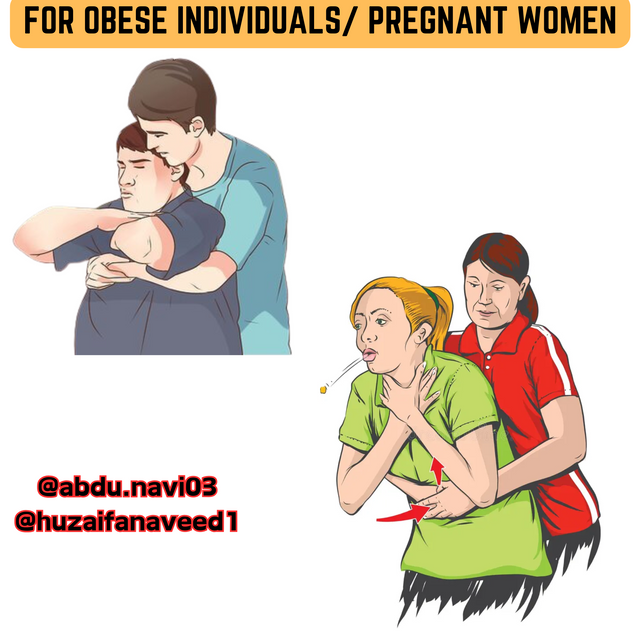
5. PREVENTING CHOKING
FOR CHILDREN:
Keep small objects and hazardous foods (nuts, hard candy, grapes) out of reach.
Supervise meal times and encourage small, well-chewed bites.
Avoid giving small, hard foods like nuts, candies, or whole grapes.
Cut food into small, manageable pieces.
Teach children to chew thoroughly and sit while eating.
Securely store small objects like toys, coins, and batteries out of reach.
Supervise mealtimes and playtimes, especially for toddlers.
FOR ADULTS
Avoid talking or laughing while eating.
Cut food into small, manageable pieces.
Be cautious with dentures or other oral appliances.
Avoid talking or laughing while eating.
Chew food thoroughly and avoid rushing meals.
Be cautious with alcohol consumption during meals, as it may impair swallowing.
Maintain oral hygiene and ensure dentures fit properly.
IN THE WORKPLACE or PUBLIC PLACES
Train employees or staff in basic first aid techniques.
Display choking first aid posters in visible areas.
Equip kitchens and public spaces with easy-to-access first aid kits.
FOR AT-RISK INDIVIDUALS
Educate caregivers on managing choking incidents for those with swallowing difficulties, such as the elderly or people with medical conditions.
Regularly review swallowing safety during meals with healthcare professionals.
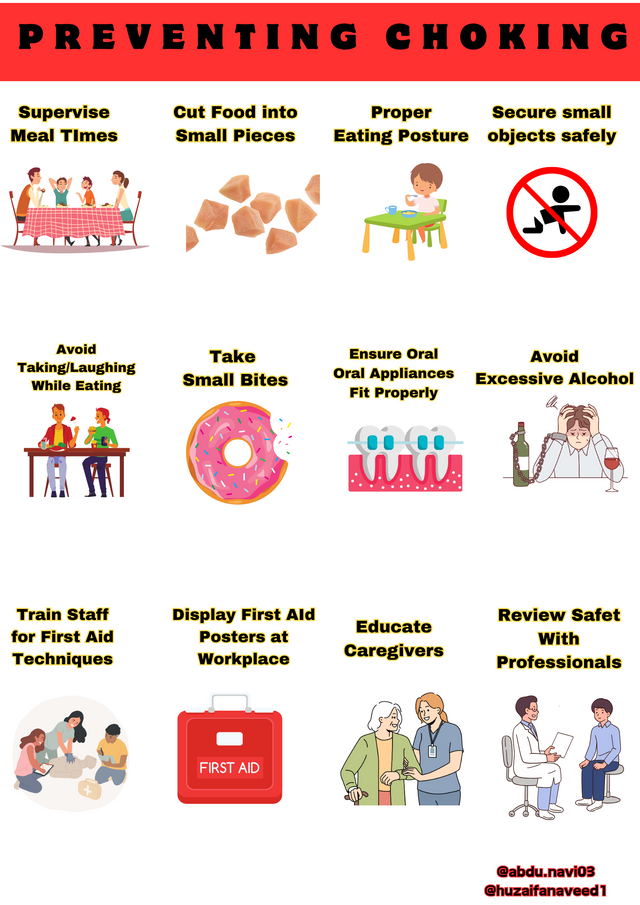
SUMMARY OF TECHNIQUES USED TO HANDLE CHOKING |
|---|
| Maneuver | Who It’s For | Technique | Purpose |
|---|---|---|---|
| Heimlich Maneuver | Adults and children >1 year | Quick, upward abdominal thrusts | Expels the object with air pressure |
| Back Blows | All ages | Firm blows between the shoulder blades | Dislodges the obstruction |
| Chest Thrusts | Infants and certain adults | Inward compressions on the chest | Safe alternative to abdominal thrusts |
| Finger Sweep | Unconscious individuals | Manual removal of visible obstructions | Removes the object |
| CPR | Unresponsive individuals | Chest compressions and rescue breaths | Maintains oxygen flow and may clear the airway |
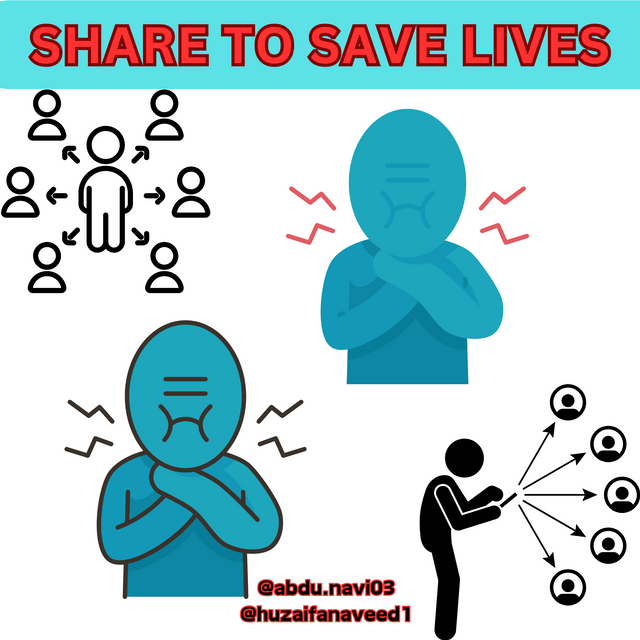
Choking is a life-threatening emergency, but with the right knowledge and quick action, lives can be saved. By understanding the causes, recognizing the signs, and mastering first aid techniques, you equip yourself to respond effectively to such critical situations.
Prevention is equally vital—ensuring safe eating habits, childproofing environments, and promoting awareness in public spaces can significantly reduce the risk of choking incidents. Together, we can create a safer world by staying informed, prepared, and vigilant.
Always remember: staying calm and acting swiftly can make all the difference. Share this guide with others and help spread awareness—it could save a life!
HOMEWORK |
|---|
Q1: Describe in detail the mechanism of choking. What happens physiologically when the airway is obstructed? List and explain the distinctive features or signs of choking, including how to differentiate between partial and complete obstruction.
Q2: Demonstrate the Heimlich maneuver on a sibling, child, or peer (using safe simulations). Attach pictures of the demonstration and explain the procedure in detail, highlighting key points such as positioning, technique, and safety precautions..
Q3: Consider a situation where you encounter a conscious person choking on food. They are showing signs of cyanosis and restricted breathing.
Describe how you will prioritize and manage the situation. Write each step in detail, from identifying choking to performing first aid and ensuring the victim's safety. Include how you would take control of the situation, communicate with bystanders, and seek medical assistance if needed.
Q4: Create an infographic (visual illustration) on managing choking emergencies.
Your design should include key steps, such as how to identify choking, perform back blows, abdominal thrusts, and manage choking in special cases (e.g., infants, pregnant individuals). Ensure your infographic is clear, visually engaging, and easy to understand.
RULES |
|---|
Your title should be "SLC21/WK5: Choking and Airway Obstruction: A Complete Guide to Life-Saving First Aid Techniques "
Make sure to use the #firstaid-s21w5 , #steemexclusive, #teachingteam , #learnwithsteem tags, and your country's tag (e.g., #pakistan)
Plagiarism or the use of artificial intelligence of any kind will not be tolerated.
Only your own images will be accepted (Try to create it on various softwares like Canva, etc) Images for free use will not be allowed.
Write a minimum of 800 words
The link of your task must be added in the comments of this publication.
Use the #burnsteem25 tag only if you have set the 25% payout to @null.
You can publish homework in any community and in any language. But don't forget to use the original tag.
Invite three of your active Steemian friends.
The participation schedule is between Monday, November 25th, 2024, at 00:00 UTC to Sunday, - December 1st, 2024, at 23:59 UTC.
REWARDS |
|---|
SC01/SC02 would be checking on the entire 17 participating Teaching Teams and Challengers and upvoting outstanding content. Upvote is not guaranteed for all articles. Kindly take note.
At the end of the contest, I will be nominating four (04) users who have had a great performance in the contest and have complied with the previously established, and therefore, are eligible to receive SC01/SC02 votes.
Contact Information (Discord)
@abdu.navi03 (abdu.navi03)
@huzaifanaveed1 (huzaifa_1114)
Best regards,
Dr @abdu.navi03
Dr @huzaifanaveed1
SLC21/WK5: Choking and Airway Obstruction: A Complete Guide to Life-Saving First Aid Techniques
Downvoting a post can decrease pending rewards and make it less visible. Common reasons:
Submit
https://steemit.com/firstaid-s21w5/@nanidi/slc21-wk5-asfixia-y-obstruccion-de-las-vias-respiratorias-una-guia-completa-sobre-tecnicas-de-primeros-auxilios-que-salvan-vidas mi entrada!
Downvoting a post can decrease pending rewards and make it less visible. Common reasons:
Submit
Una excelente propuesta la que nos trae para esta semana, seguro que estaré participando muy pronto.
Este tema es algo muy necesario que todos sepamos manejar, en mis experiencias, cuando menos uno se lo espere se puede ver involucrado en una situación en la que se amerite usar esta técnica para despejar vías respiratorias.
Estaré atento a las participaciones.
Saludos
Downvoting a post can decrease pending rewards and make it less visible. Common reasons:
Submit
https://steemit.com/hive-118902/@xkool24/slc21-wk5-choking-and-airway-obstruction-a-complete-guide-to-life-saving-first-aid-techniques
Downvoting a post can decrease pending rewards and make it less visible. Common reasons:
Submit
Here is my entry
https://steemit.com/hive-109435/@memamun/slc21-wk5-choking-and-airway-obstruction-a-complete-guide-to-life-saving-first-aid-techniques
Downvoting a post can decrease pending rewards and make it less visible. Common reasons:
Submit
https://steemit.com/firstaid-s21w5/@aril.hatake/slc21-wk5-choking-and-airway-obstruction-a-complete-guide-to-life-saving-first-aid-techniques
Downvoting a post can decrease pending rewards and make it less visible. Common reasons:
Submit
My entry
https://steemit.com/hive-168205/@neelofar/slc21-wk5-or-or-choking-and-airway-obstruction-or-a-complete-guide-to-life-saving-first-aid-techniques
Downvoting a post can decrease pending rewards and make it less visible. Common reasons:
Submit
Quite educative. I hope there is a continuity in your course teachings so we can learn more about life-saving techniques. Impressive teaching👍
Downvoting a post can decrease pending rewards and make it less visible. Common reasons:
Submit
Best regards, this is my participation post :
https://steemit.com/hive-167213/@fantvwiki/slc21-wk5-choking-and-airway-obstruction-a-complete-guide-to-life-saving-first-aid-techniques
Downvoting a post can decrease pending rewards and make it less visible. Common reasons:
Submit
This is my entry link
https://steemit.com/firstaid-s21w5/@adese/slc21-wk5-choking-and-airway-obstruction-a-complete-guide-to-life-saving-first-aid-techniques
Downvoting a post can decrease pending rewards and make it less visible. Common reasons:
Submit
Mi participación
https://steemit.com/hive-188619/@sammy1109/slc21-wk5-choking-and-airway-obstruction-a-complete-guide-to-life-saving-first-aid-techniques
Compartido en twt (X)
https://x.com/SamxioI/status/1863054535981142475
Downvoting a post can decrease pending rewards and make it less visible. Common reasons:
Submit
Entry
https://steemit.com/hive-168205/@sbamsoneu/slc21-wk5-choking-and-airway-obstruction-a-complete-guide-to-life-saving-first-aid-techniques
Downvoting a post can decrease pending rewards and make it less visible. Common reasons:
Submit
https://steemit.com/hive-168205/@artist1111/slc21-wk5-choking-and-airway-obstruction-a-complete-guide-to-life-saving-first-aid-techniques
Downvoting a post can decrease pending rewards and make it less visible. Common reasons:
Submit
My entry : https://steemit.com/firstaid-s21w5/@pea07/slc21-wk5-choking-and-airway-obstruction-a-complete-guide-to-life-saving-first-aid-techniques
Downvoting a post can decrease pending rewards and make it less visible. Common reasons:
Submit
My entry
https://steemit.com/hive-168205/@rossnenye/slc21-wk5-choking-and-airway-obstruction-a-complete-guide-to-life-saving-first-aid-techniques-by-rossnenye
Downvoting a post can decrease pending rewards and make it less visible. Common reasons:
Submit